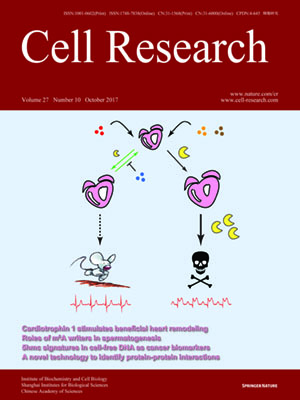
Volume 27, No 10, Oct 2017
ISSN: 1001-0602
EISSN: 1748-7838 2018
impact factor 17.848*
(Clarivate Analytics, 2019)
Volume 27 Issue 10, October 2017: 1258-1274
ORIGINAL ARTICLES
Genome-wide identification of histone H2A and histone variant H2A.Z-interacting proteins by bPPI-seq
Yi Zhang1,2,3,*, Wai Lim Ku2,*, Shuai Liu2, Kairong Cui2, Wenfei Jin2, Qingsong Tang2, William Lu2, Bing Ni1,3 and Keji Zhao2
1Institute of Immunology PLA, Third Military Medical University, Chongqing 400038, China
2Systems Biology Center, Division of Intramural Research, NHLBI, NIH, Bethesda, MD 20892, USA
3Department of Pathophysiology and High Altitude Pathology, Third Military Medical University, Chongqing 400038, China
Correspondence: Keji Zhao, E-mail: zhaok@nhlbi.nih.gov; Bing Ni,(nibingxi@126.com)
H2A is a nucleosome core subunit involved in organizing DNA into a chromatin structure that is often inaccessible to regulatory enzymes. Replacement of H2A by its variant H2A.Z renders chromatin accessible at enhancers and promoters. However, it remains unclear how H2A.Z functions so differently from canonical H2A. Here we report the genome-wide identification of proteins that directly interact with H2A and H2A.Z in vivo using a novel strategy, bPPI-seq. We show that bPPI-seq is a sensitive and robust technique to identify protein-protein interactions in vivo. Our data indicate that H2A.Z-interacting proteins and H2A-interacting proteins participate in distinct biological processes. In contrast to H2A-interacting proteins, the H2A.Z-interacting proteins are involved in transcriptional regulation. We found that the transcription factor Osr1 interacts with H2A.Z both in vitro and in vivo. It also mediates H2A.Z incorporation to a large number of target sites and regulates gene expression. Our data indicate that bPPI-seq can be widely applied to identify genome-wide interacting proteins under physiological conditions.
10.1038/cr.2017.112
FULL TEXT | PDF
Browse 1901


